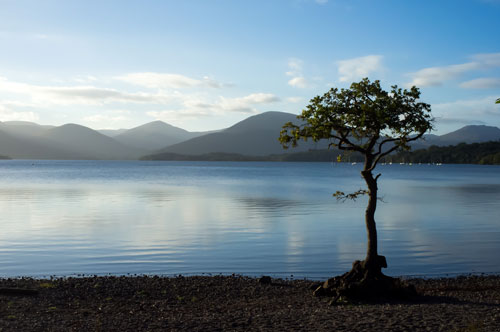Fort William
Fort William (Gaelic: An Gearasdan, "The Garrison") is the largest town in the highlands of Scotland and second largest highland settlement behind the city of Inverness. It is a major tourist centre with Glen Coe just to the south, Glenfinnan to the west, and is itself directly on the Road to the Isles. It is an important centre for hillwalking and climbing due to its proximity to Ben Nevis and many other Munros (mountains of 3000 feet or higher), marketing itself as the "Outdoor Capital of the UK".
It is also well known for its nearby famous Downhill Mountain Bike Track and its connection to the West Highland Way from Glasgow and the Great Glen Way; a walk/cycle way from Inverness to Fort William through the Great Glen.

Location
Originally based around the village of Inverlochy, the town lies at the southern end of the Great Glen, on the shores of Loch Linnhe and Loch Eil. It is close to Ben Nevis, the highest mountain in the British Isles, and Glen Nevis.
History
Historically, this area of Lochaber was strongly Clan Cameron country, and there were a number of mainly Cameron settlements in the area (such as Blarmacfoldach). The nearby settlement of Inverlochy was the main settlement in the area before the building of the fort, and was also site of the Battle of Inverlochy. However, the town is not of local origin. It grew up as a settlement next to a fort constructed to control the population after Oliver Cromwell's invasion during the English Civil War, and then to suppress the Jacobite uprisings of the 18th century.
The fort was named "Fort William"' after William Of Orange, and the settlement that grew around it was called "Maryburgh", after his wife. This settlement was later renamed "Gordonsburgh", and then "Duncansburgh" before being renamed back to "Fort William", this time after Prince William, Duke of Cumberland; known to some Scots as "Butcher Cumberland". Given these origins, there have been various suggestions over the years to rename the town (for example, to "Invernevis"). These proposals have led to nothing as of yet.
Fort William is the northern end of the West Highland Way, a long distance route which runs 95 miles through the Scottish Highlands to Milngavie, on the outskirts of Glasgow, and the start/end point of the Great Glen Way, which runs between Fort William and Inverness.
Geography
Fort William lies on the shores of Loch Linnhe (sea loch) beside the mouth of the rivers Nevis and Lochy. They join in the tidal zone to briefly become one river before discharging to the sea.

The town and its suburbs, surrounded by picturesque mountains, follow the curved contour of the end of the longest sea loch in Scotland. The town is centred on the High Street, which was pedestrianised in the 90s. Off this there are several squares. Monzie Square (named after the Cameron Campbells of Monzie, Perthshire, former landowners in the town), Station Square, where the long-since demolished but often lamented railway station used to be, Gordon Square (named for the Gordons, who owned land where the town now stands in the late 1700s, during which time the town was named Gordonsburgh), and Cameron Square - formerly known as Church Square.
The main residential areas of the town are unseen from the high street or the A82 main road. Upper Achintore and the Plantation spread steeply uphill from above the high street. Inverlochy, Claggan, Lochyside, Caol, Banavie and Corpach outwith the town are the other main residential areas. These areas are built on much flatter land than the town.
Nearby is Glenfinnan, home of the Glenfinnan Monument (Jacobite era) and Viaduct (the viaduct is also known as the "Harry Potter Bridge"). Glenfinnan has also been used in: Charlotte Gray, Highlander and other Harry Potter films.
Just outside the town is a large aluminium plant, powered by the Lochaber hydroelectric scheme, in its day the biggest tunnelling project in the world. This was formerly served by the Lochaber Narrow Gauge Railway better known locally as the Puggie.
Transport
The West Highland Line passes through Fort William. Owing to the difficult terrain in the area, the line from Glasgow, to the south, enters from the northeast and trains from Glasgow to Mallaig, the terminus of the line, have to reverse at Fort William railway station.
The Caledonian Canal connects the Scottish east coast at Inverness with the west coast at Corpach near Fort William.
Mountain Biking
Just outside the town, parallel to the Nevis Range Gondola there is a large downhill mountain bike track, this attracts thousands every year, including international competitors and fans. Alongside this, there are the "Witches Trails", which unusually attract more than the downhill track.
Further information on Fort William can be found on the excellent fortwilliam.co.uk
